|
San Diego City and County Historic Designations
By Ann Jarmusch
March/April 2024
At the January 2024 meeting of the City of San Diego Historical Resources Board, members heard public testimony on the proposed Talmadge Park Estates Historic District (1926-1951) before voting 6-2 to approve it in concept. As other groups have done to allow for the process of creating a historic district, Talmadge residents bypassed local designation because the local process has hopelessly stalled. Instead, they worked with the State Office of Historic Preservation to nominate the district for the National Register of Historic Places. The city’s heritage preservation staff reviewed the report’s methodology and findings, concurred, and recommended that the board give the nomination the green light.
Opponents argued that in the past, the neighborhood was plagued by redlining and racial discrimination, and that segregation contributed to it becoming the affluent community it is today.
Several board members responded that despicable racism and redlining were woven into many formerly segregated San Diego neighborhoods. Some of them are now historic districts praised for their diversity and sense of community, as well as their architectural and social heritage.
HRB member Carla Farley, who is a real estate broker, added that redlining was not only widespread in 20th-century San Diego, it was so prevalent that she called it “normal.” Fellow member and attorney Courtney Ann Coyle said, “I feel the urge to say we’re all sitting on Kumeyaay land, so let’s go back and talk about settler colonialism…” Bruce Coons, SOHO’s Executive Director, observed that Talmadge Park Estates “has been eminently qualified” for historic district status for decades, and that rather than being exclusive, it “has a huge amount of Naturally Occurring Affordable Housing, and always has.”
Kelley Stanco, deputy director of the City of San Diego Planning Department, addressed racism and redlining when she said, “Unfortunately, racially restrictive covenants were not unique to Talmadge Park Estates in San Diego, or California, and were rightfully deemed unenforceable in 1948 by the Supreme Court before being outlawed 20 years later. The designation of properties in districts that held such covenants does not condone or in any way legitimize these deplorable practices, nor does it preclude new homes from being constructed within a historic district."
The State Historical Resources Commission approved the nomination on February 2, 2024.
In HRB news, member Bruce Abrams resigned in December 2023; Chairperson Tim Hutter thanked him for his service on the board and its policy subcommittee. Staff reported on the status of designation appeals. The City Council upheld the recent designations of the Donald and Gladys Clitsome/Lloyd Ruocco House and the Velma Prichard Spec House #1 on December 5, 2023. The council is tentatively scheduled to hear the appeals of the Lucile Hamilton/Robert Mosher House and the Frank and Rosa Woodford House on February 26, 2024.
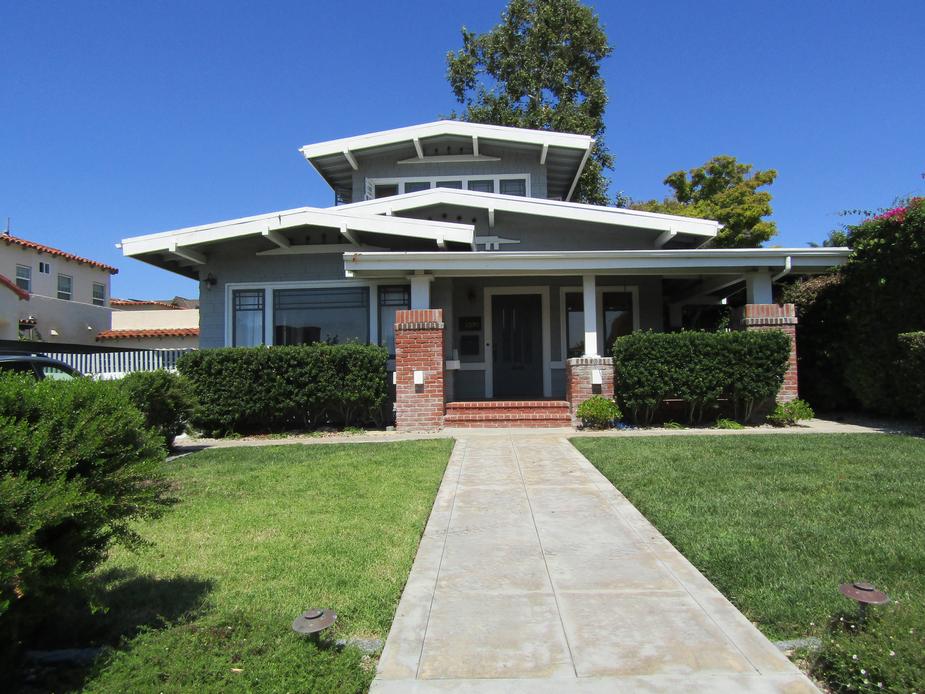 |
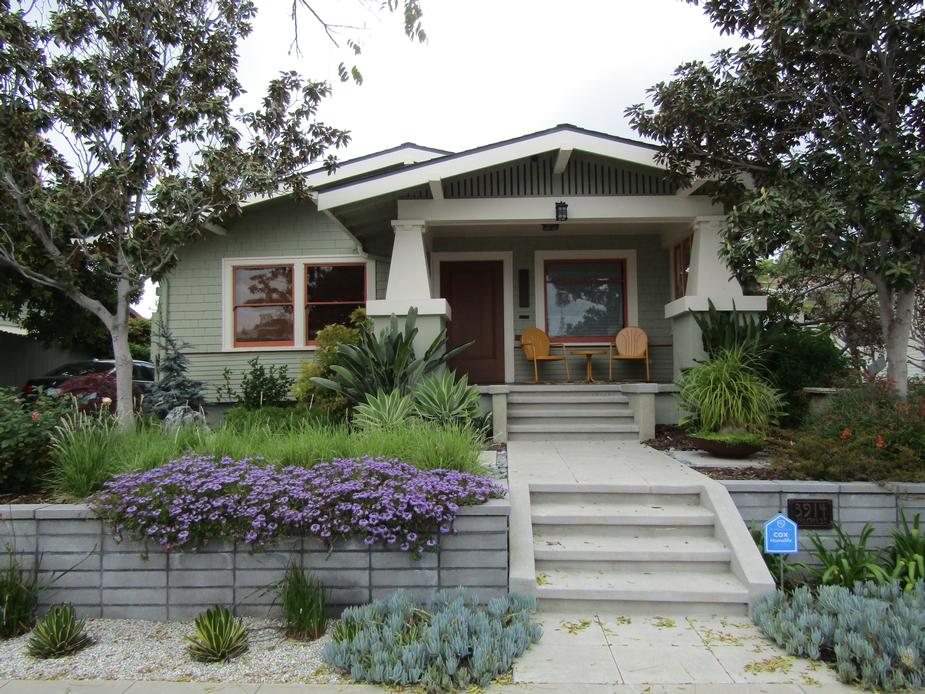 |
Left to right Donald and Gladys Clitsome/Lloyd Ruocco House, Velma Prichard Spec House #1 |
Staff member Suzanne Segur also reported progress on the Botanical Building restoration project in Balboa Park: The refurbished cupola was returned to the top of the building’s dome. Planning has begun for Phase 2 of the project, which includes the restoration of exterior fountains and the reconstruction of a historic pergola.
The HRB also approved the staff-written City of San Diego Standardized Report of City Boards and Commissions for 2023, with minor changes. Due to limited meeting time, the HRB could not address its entire agenda, and tabled the designation nominations of three local houses to its February meeting.
At their February 2024 meeting, the HRB approved amendments to board procedures regarding management of the “consent” portion of the agenda, which allows an agenda item, including staff-recommended historic designations, to be approved without discussion. The changes align HRB procedures with those of the City Council to streamline meetings. They also enable the board to note for the record, then potentially bypass citizens’ unsubstantiated challenges to nominated historic resources. Presently, citizens’ ongoing baseless objections, the board concurred, have disrupted board business, inconvenienced applicants and the public, and resulted in unnecessarily longer public meetings in rooms with time limits and competition for use. The new procedures take effect at the March 28, 2024, HRB meeting.
Residents and organizers of the Talmadge Park Estates National Historic District announced its approval by the California State Historical Resources Commission on February 2, 2024. They denounced misinformation published in the media about Talmadge Park and National Historic District “privileges,” statements they said they plan to counter with their own op-ed piece. They created a digital tool for conducting community surveys of potential historic resources that they want to share with other neighborhoods, and suggested that because the tool would save heritage preservation staff time the city might apply for a grant to share it widely.
A Mission Hills Heritage representative reminded the HRB that the group is still waiting for the Policy Subcommittee to discuss board procedural changes they proposed to create a path for National Historic Districts, such as Inspiration Heights, to be added to the local register.
A member of the Neighborhood Historic Preservation Coalition called attention to a letter the group’s one dozen entities recently sent to the HRB recommending that the city commission a study on the economic impact of historic preservation in San Diego, as other major cities have done.
Bruce Coons, SOHO’s executive director, provided answers to questions about local, state, and national historic designation levels that HRB members asked at the January 2024 meeting. "Designation at the local level is the most liberal," Coons said, "with state and national designation increasingly rigorous. Why are communities like Talmadge Park Estates and Inspiration Heights leapfrogging over local historic district designation to secure National Historic District status? That’s because city staff is decades behind in evaluating and processing historic districts, such as Golden Hill," he said. Because San Diego is a state Certified Local Government (CLG), the HRB can comment, as a courtesy, on state and national nominations, as they did with the Talmadge Park Estates application for National Historic District status at their January 2024 meeting.
In addition, Coons cautioned that the City’s recently launched reform process called Preservation and Progress must uphold state and national historic preservation program requirements, such as HRB member qualifications, to retain its CLG status. Only CLGs are eligible for Community Development Block Grants.
Good news: The Planning Department is bringing back the Historical Resources Board Preservation Awards, to be announced in May, National Preservation Month. Nominations, which are now open, close April 5, 2024. Click for details and to submit nominations.
Finally, the board designated five houses. See descriptions below.
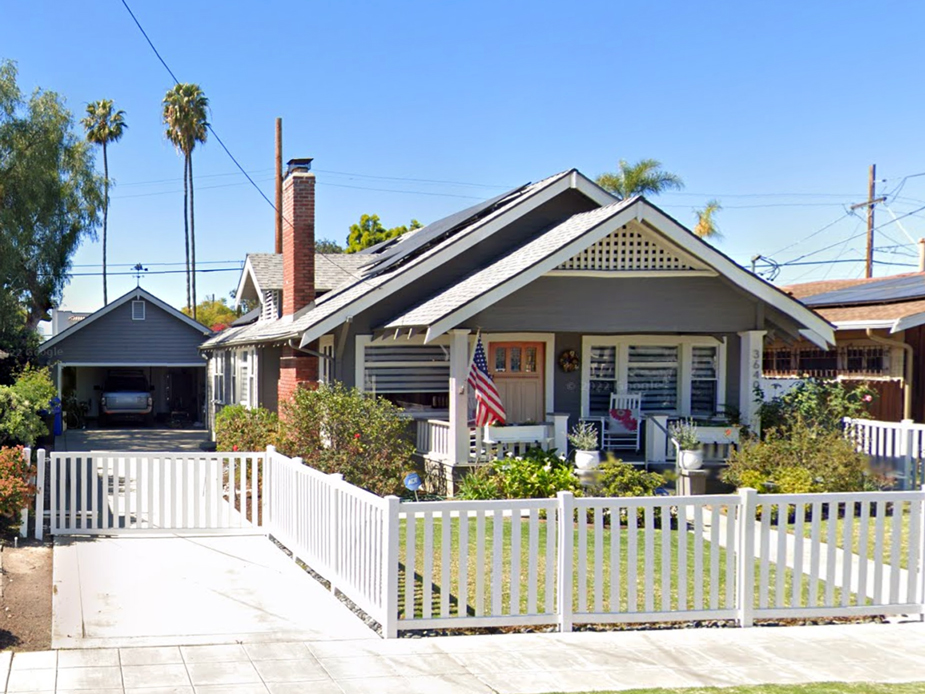 3640 Utah Street, in the North Park Community, is the Craftsman style Robert and Addie Lane House, built in 1912. Designated under HRB Criterion C for Craftsman architecture with the integrity of its original design intact. It embodies distinctive characteristic of the style, including one-story massing, horizontal wood siding, overhanging eaves with exposed angled rafter tails, partial-width front porch supported by square posts, front gable roof, gable dormer, triangular knee braces, decorative attic vents, and wood-frame and sash double-hung windows, as well as casement, fixed, and tripartite windows. The designation excludes the pre-1962 rear addition, the 1999 addition, and the 1999 detached garage. Courtesy Google street view 3640 Utah Street, in the North Park Community, is the Craftsman style Robert and Addie Lane House, built in 1912. Designated under HRB Criterion C for Craftsman architecture with the integrity of its original design intact. It embodies distinctive characteristic of the style, including one-story massing, horizontal wood siding, overhanging eaves with exposed angled rafter tails, partial-width front porch supported by square posts, front gable roof, gable dormer, triangular knee braces, decorative attic vents, and wood-frame and sash double-hung windows, as well as casement, fixed, and tripartite windows. The designation excludes the pre-1962 rear addition, the 1999 addition, and the 1999 detached garage. Courtesy Google street view
|
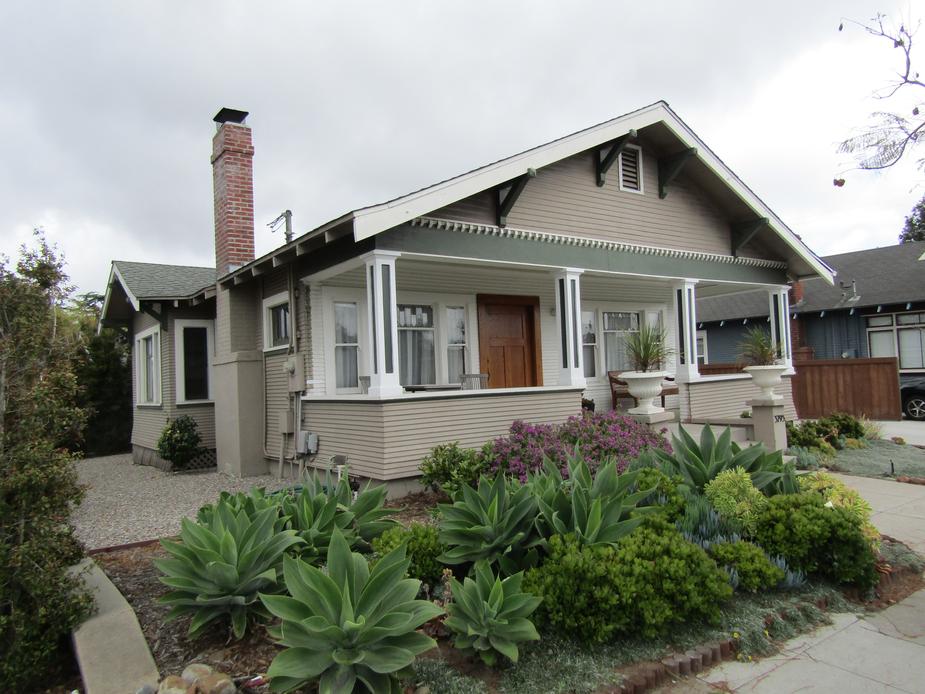 3795 Goldfinch Street and 825 Bush Street, in the Uptown Community, encompasses two residences on the same parcel with the same owner. Both were built in the Craftsman style, but in different years: 1913 and 1925. Staff recommended designating only the older, larger home on Goldfinch, but the HRB voted to designate both under HRB Criterion C, for architecture. Board members said that 825 Bush Street is a smaller, more modest version of 3795 Goldfinch Street, and that it represents a worker’s cottage, of which not many have been designated historic in San Diego. The resource is known as the Ernest and Mary Waidmann House, named for the original owners who lived in the house facing Goldfinch. Both houses embody distinctive, character-defining features of Craftsman style architecture and retain integrity from the year each was built. 3795 Goldfinch features one-story massing, wood clapboard siding, a full-width front porch supported by square columns, a low-pitched front gable roof, exposed rafters with projecting rafter tails, triangular knee braces, and wood-frame and sash double-hung windows, plus casement, fixed, and tripartite windows. Also a one-story house, 825 Bush Street has a symmetrical front facade, overhanging eaves with exposed rafter ends, and a low-pitched roof. Clad in narrow clapboard siding, this house has a raised entry with a gabled porch cover supported by solid triangular brackets. The porch cover displays a similar dentil course as the more pronounced one at 3795 Goldfinch Street. The Bush Street house’s front facade features a pair of nine-divided-light, double-hung, wood-framed windows that flank a centered, nine-divided-light French door. The designation excludes a detached shed. 3795 Goldfinch Street and 825 Bush Street, in the Uptown Community, encompasses two residences on the same parcel with the same owner. Both were built in the Craftsman style, but in different years: 1913 and 1925. Staff recommended designating only the older, larger home on Goldfinch, but the HRB voted to designate both under HRB Criterion C, for architecture. Board members said that 825 Bush Street is a smaller, more modest version of 3795 Goldfinch Street, and that it represents a worker’s cottage, of which not many have been designated historic in San Diego. The resource is known as the Ernest and Mary Waidmann House, named for the original owners who lived in the house facing Goldfinch. Both houses embody distinctive, character-defining features of Craftsman style architecture and retain integrity from the year each was built. 3795 Goldfinch features one-story massing, wood clapboard siding, a full-width front porch supported by square columns, a low-pitched front gable roof, exposed rafters with projecting rafter tails, triangular knee braces, and wood-frame and sash double-hung windows, plus casement, fixed, and tripartite windows. Also a one-story house, 825 Bush Street has a symmetrical front facade, overhanging eaves with exposed rafter ends, and a low-pitched roof. Clad in narrow clapboard siding, this house has a raised entry with a gabled porch cover supported by solid triangular brackets. The porch cover displays a similar dentil course as the more pronounced one at 3795 Goldfinch Street. The Bush Street house’s front facade features a pair of nine-divided-light, double-hung, wood-framed windows that flank a centered, nine-divided-light French door. The designation excludes a detached shed.
|
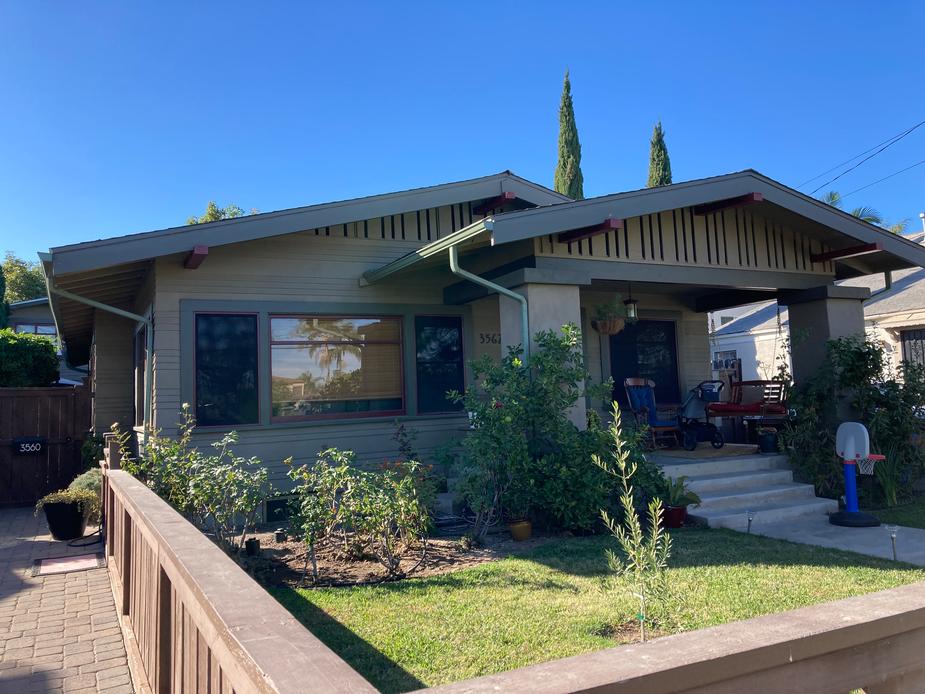 3560-3562 Utah Street, in North Park, is the Ralph Hurlburt/Alexander Schreiber Spec. House #5, built in 1919. The home meets HRB Criterion C, for embodying and retaining its Craftsman style architectural design and features, and Criterion D, as a notable work by Master Builder Alexander Schreiber. The house’s Craftsman hallmarks include low-pitched, gable roofs with wide overhanging eves; exposed beams; wood clapboard siding with a distinct board pattern; a partial width front porch with square stucco columns; a stucco chimney; fenestration consisting of wood-framed, double-hung and fixed windows; and decorative attic vents. 3560-3562 Utah Street, in North Park, is the Ralph Hurlburt/Alexander Schreiber Spec. House #5, built in 1919. The home meets HRB Criterion C, for embodying and retaining its Craftsman style architectural design and features, and Criterion D, as a notable work by Master Builder Alexander Schreiber. The house’s Craftsman hallmarks include low-pitched, gable roofs with wide overhanging eves; exposed beams; wood clapboard siding with a distinct board pattern; a partial width front porch with square stucco columns; a stucco chimney; fenestration consisting of wood-framed, double-hung and fixed windows; and decorative attic vents.
|
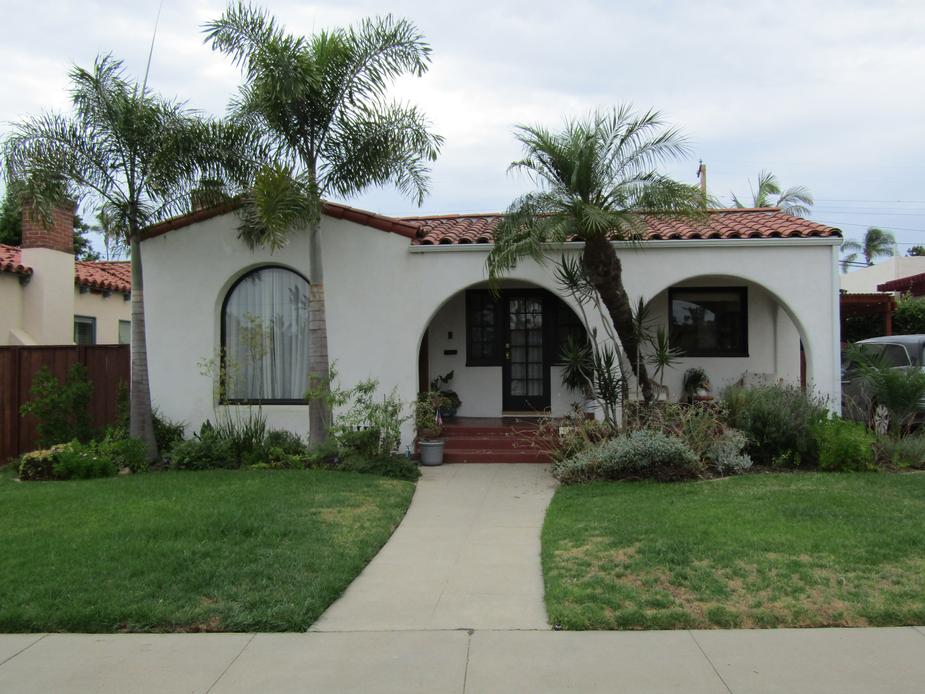 4952 Marlborough Drive, in the Kensington Community, is a 1928 Spanish Colonial Revival home. The Harry and Edna Payne/Carl B. Hays House meets HRB Criterion C, for being an outstanding example of the Spanish Colonial Revival style; and Criterion D, as a notable example of the signature style and quality craftsmanship of Master Builder Carl B. Hays. Its distinctive design characteristics include an asymmetrical facade, a stucco exterior, low-pitched tile roof with little eave overhang, arched focal window, arched porch openings, varied roof forms, and wood-framed windows. Hays was a prominent and accomplished building contractor responsible for many homes in Kensington and throughout San Diego. The designation includes the original detached garage. It excludes the rear 2021 addition. 4952 Marlborough Drive, in the Kensington Community, is a 1928 Spanish Colonial Revival home. The Harry and Edna Payne/Carl B. Hays House meets HRB Criterion C, for being an outstanding example of the Spanish Colonial Revival style; and Criterion D, as a notable example of the signature style and quality craftsmanship of Master Builder Carl B. Hays. Its distinctive design characteristics include an asymmetrical facade, a stucco exterior, low-pitched tile roof with little eave overhang, arched focal window, arched porch openings, varied roof forms, and wood-framed windows. Hays was a prominent and accomplished building contractor responsible for many homes in Kensington and throughout San Diego. The designation includes the original detached garage. It excludes the rear 2021 addition.
|
All photos are from the California Historical Resources Inventory Database (CHRID), except where noted otherwise. The above designations were reviewed and approved by the City of San Diego Historical Resources Board (HRB), the County of San Diego Historic Site Board (HSB), or the Coronado Historic Resources Commission.
|
2025
2024
2023
2022
2021
2020
2019
2018
2017
2016
2015
|









